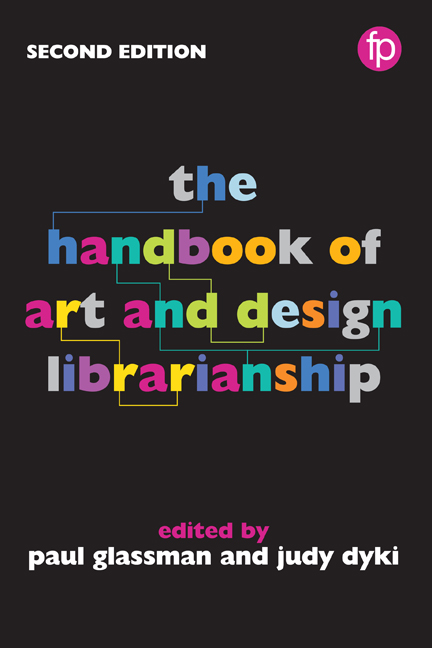Book contents
- Frontmatter
- Contents
- List of figures and tables
- Notes on contributors
- Foreword
- Preface
- Part I Roles and responsibilities
- 1 The governance and administration of the art and design library
- 2 Evolution not revolution: evolving trends in art and design libraries
- 3 Expanding roles for fine arts liaison librarians: re-visioning the liaison model
- 4 Accreditation and visual arts libraries
- 5 Design thinking for design librarians: rethinking art and design librarianship
- Part II Materials and collection management
- Part III Teaching and learning
- Part IV Knowledge creation
- Part V The physical environment
- Part VI Promotion and sustainability
- Appendix Library profiles
- Index
5 - Design thinking for design librarians: rethinking art and design librarianship
from Part I - Roles and responsibilities
Published online by Cambridge University Press: 08 June 2018
- Frontmatter
- Contents
- List of figures and tables
- Notes on contributors
- Foreword
- Preface
- Part I Roles and responsibilities
- 1 The governance and administration of the art and design library
- 2 Evolution not revolution: evolving trends in art and design libraries
- 3 Expanding roles for fine arts liaison librarians: re-visioning the liaison model
- 4 Accreditation and visual arts libraries
- 5 Design thinking for design librarians: rethinking art and design librarianship
- Part II Materials and collection management
- Part III Teaching and learning
- Part IV Knowledge creation
- Part V The physical environment
- Part VI Promotion and sustainability
- Appendix Library profiles
- Index
Summary
Introduction
For thousands of years, libraries and librarians have designed tools and services to enable access to and use of information resources. Protocols like cataloguing rules, classification schemes, co-operative programmes and readers’ advisory were the expert purview of libraries around the world for centuries, enabling and assisting users with access to information. With special attention to unique information behaviours practised by artists and other creative patrons, art and design proffer similar expertise, often developing specialized tools and services to overcome obstacles and solve problems other libraries may not typically face.
But despite a historical track record of innovative tool and service creation, American librarianship is traditionally considered a social science field. Although the application of specific methodologies varies, scientific perspectives pervade library practice, research and teaching, from Pierce Butler's early admonition for application of positivist thought in the library field (1933) to today's contemporary emphasis on ‘evidence-based librarianship’ (Eldredge, 2006). Various methods and methodological approaches were drawn on throughout the 20th century, yet few have approached librarianship as if it was not a science at all.
In recent years, alternatives to traditional scientific approaches have emerged. One of these is design. Many people think of design in specific, applied contexts, like fashion design or architecture. However, a well established record of research across numerous applied fields shows that design reflects creative approaches that differ from traditional science.
This chapter illustrates the relevance of design approaches to librarianship and how design principles and methods can apply to art and design libraries. After a general overview of design writ large and how it relates to librarianship in general, the chapter discusses one particular approach in more depth: the design thinking process. Recommendations for art and design librarians are then offered, with special attention to how their unique backgrounds and skill sets might dovetail with this approach.
Librarianship as design
What is design? Ask ten people and you will get eleven different answers. By dictionary definition, ‘design’ means ‘to create, fashion, execute, or construct according to plan; to conceive and plan out in the mind; to have as a purpose; to devise for a specific function or end’ (Merriam-Webster, 2017).
- Type
- Chapter
- Information
- The Handbook of Art and Design Librarianship , pp. 41 - 50Publisher: FacetPrint publication year: 2017



